After I explained how many different types of maps I had recently consulted — topographical, burn intensity, forest type, land ownership — before going mushroom hunting, a friend told me I was type A about everything, even wandering around in the woods.
My first impulse was to deny it. Nobody wants to be an uptight perfectionist who can’t relax. But she was right. Those personality traits are a mixed blessing, but they are unambiguously mine. Paradoxically, I think this is why I enjoy looking for mushrooms so much: it is a quantum activity, simultaneously goal-oriented and freeform, that both rewards preparation and hinges almost entirely on chance.
Oregon is full of serious mushroom hunters. Every household seems to have their own dog-eared copy of All That the Rain Promises and More, wrinkled with ambient moisture, spruce needles wedged between the pages. I’ve dabbled for years but still consider myself a rank amateur, and I have an especially terrible track record with morels, those strange, hollow, leathery entities that emerge seemingly at random each spring like semi-sentient pine cones. Until recently I could count the number I’ve found on one hand, although everyone around me seems to be finding them everywhere, including amongst the landscaping of their suburban office park and, in the case of my neighbor, in the yard next to his canoe.
I’d always heard that burned land was a rich source of a specific sort of morels that fruits in wild abundance following a fire. “You wouldn’t believe the quantity coming out of burns in Idaho and Montana,” a former mushroom wholesaler once told me as he gave me a ride in the quintessential mushroom vehicle, an old minivan, to the unloading of a woodfired kiln. “Thousands and thousands of pounds a day.” At one time he had been the largest mushroom wholesaler in Portland, complete with a storage warehouse in the Southeast industrial district. He loved his work. But he had to call it quits after the stress became too much. “It’s a cash business,” he said, and he finally couldn’t bear the anxiety of spending day after day driving around the remote backcountry of the Northwest with a car full of bills on the hunt for secretive, protective weirdos with something to sell.
If I was ever going to find more than one morel, I figured, it would be in a burned forest, which are now all around us. So I signed up for a field trip with the Oregon Mycological Society to look for them in the Williams Mine fire, but I didn’t get a spot (there are so many budding mycologists in Oregon the field trips are filled by lottery). Then I did some Googling, came across this immensely detailed blog post from a company that makes a mapping app for mushroom hunters, and figured that, all told, it was as good as a tip, that most coveted resource of mushroom foragers.
So Andy and I drove out on a Saturday morning along the Columbia River and then up towards Trout Lake. We followed paved highways past postcard-tidy valley bottom farms with red barns and bales of hay crisp as sugar cubes, then headed up a series of twisty unpaved roads of decreasing quality and width. Soon we entered a burned area. Some sections had been partly cleared, all big open spaces punctuated with shaggy slash piles. Other sections were still standing essentially as the fire had left them, half the trees dead but still standing, the others scorched but alive.
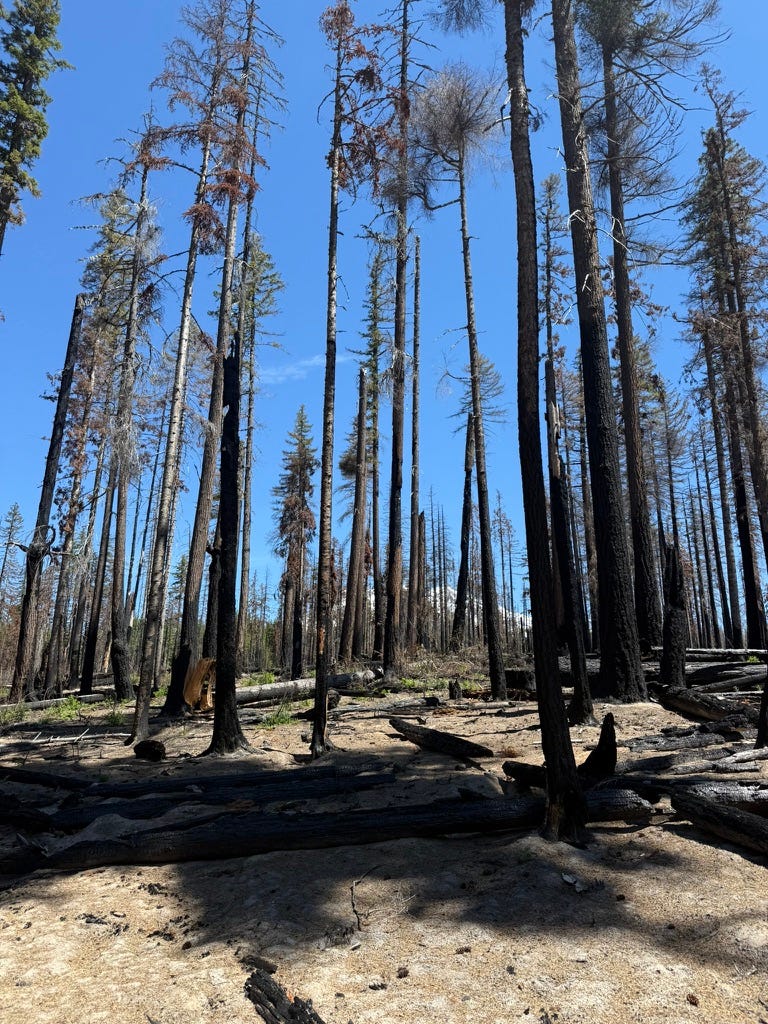
Soon, we saw the signs: Hatchbacks and sedans pulled off at the side of the road, some back far enough to be barely visible through the trees. We went up a hill and through a section that hadn’t burned at all, then stopped after crossing a small stream flowing over the road. There was a group of hikers sitting on the ground in the shade eating lunch. “…one thing we didn’t see was a mushroom,” I heard as we passed by. But in the woods, not 20 feet from where they’d been sitting, we came across three morels, tiny, but as good as a welcome mat to the woods beyond.
Burned woods are eerie, fascinating places. Fire has always been part of the landscape in the West, but over the last decade fires have burned hotter and longer, started earlier and carried on later. Right now, there is a big fire just east of Hood River on the plateau above Mosier, where the fire fighters say conditions are more like July than June. I’m still haunted by the Riverside, Beachie Creek, and Holiday Farm fires of 2020, which blanketed Portland with smoke so thick we couldn’t see to the end of our block. It’s been almost five years, but passing through those barren, desolate places on the west slope of the Cascades still feels like a funeral.
Not all burns are so severe. Many are patchy, irregular affairs, tendrils of burnt ground interlaced with ribbons of green, dead trees leaning on their living neighbors. The Williams Mine fire was one of these. Some sections were scoured clean, a cathedral architecture of black vertical lines. Others looked untouched. Everywhere, new life was sprouting: bunchberry, yarrow, trillium, willow, vanilla leaf, starry false Solomon’s seal, huckleberry, vine maple. Foresters call these pioneer plants because they grow back first, blown-in seeds finding purchase in the newly open, sunny terrain. That’s not quite the case for burn morels. Their mycelia are already present in the woods before they burn, but there’s something about the fire itself that causes them to flush en masse the next year, their furrowed little heads rising from the ashes.
Many of the morels we found were growing from where burned wood touched the ground, perhaps because moisture lingered there longest. Under one huge burned cedar we found a half-dozen sprouting from beneath roots covered in alligator char that echoed the shape of the caps themselves. After sitting down for lunch on a log, I noticed five within arms reach.
Mushrooming offers us more than just something to eat. It gives us a reason to get outside, into the woods, and then lavishly, almost decadently, accomplish very little. I suspect fishing is much the same way (somebody, please take me!). I enjoy hiking, but it’s so easy to feel like the purpose of it is getting someplace else, virtuously burning calories the whole time. Looking for mushrooms is essentially inland beach combing. It’s nice to find what you’re looking for. It’s vaguely disappointing when you don’t. But the real prize is the chance to mill around outside just sort of looking around, experiencing your surroundings in minute detail with an open mind as to what you’ll find.
I didn’t see anything particularly special out in the woods the other day. I saw blooming chocolate trillium, a few coral fungus gone leathery and crisp in the heat, and several beer cans of such ancient vintage they had pull tabs (an important secondary harvest for any forager). I came across many strange little orange-colored, cup-shaped fungus growing tight to the ground. At first I thought they were the remains of morels found by hunters before us, but I later learned they were stalked bonfire cups, sometimes called charcoal-loving elf cups, a name that feels like a treasure unto itself. Other hunts have unveiled rarer finds: Whole deer skeletons bleached clean, strange structures in the woods, once a giant Pacific salamander wallowing in the moss, its soft, speckled body as broad as my hand.
Ultimately we found a few handfuls in an hour or two — not exactly fantastical abundance, but enough for dinner that night. As we were walking back to the car, grubby with charcoal, we saw another group emerge from the woods: Two men and two dogs. They climbed into a dilapidated minivan with mismatched doors, got it running, and starting bumping down the gravel road only to pull to a stop by us. “Find anything?” They asked. They looked like real mushroom people. Grubby, tattered, in need of dental work, and clearly not what we were, which was obvious city folk in a late-model hybrid wearing dad caps and eating gluten-free sandwiches. They did not look type A, but they did look like their minivan was going to be filled to the brim with morels available for cash sale.
As we showed our meager haul I prepared to be shamed. Instead, the guy riding shotgun just shook his head and said, “We got a tip and walked all the way up that ridge.” Their cattle dog panted vigorously over his shoulder, as if to illustrate just how far. “Nothing. I found one, and he found two.” Then he gave a wry smile, and they drove away. On the way back down the hill, Andy asked if I thought it had all been misdirection — a lie to keep us from the big score we were a little too close to for comfort. I think it’s impossible to say.
Tips
In general, I think it’s good for us to go looking for something that is both specific and hard to find. The big stuff (love, happiness, satisfaction, meaning) may be as elusive as ever, but most things come to us very easily these days: The cat’s blood pressure medication, spices from the other side of the globe, a set of napkins we saw on the internet that will look good posted to the internet again, all available with a frictionless click and delivered silently to our door by a stranger.
All that’s to say: You should go look for some morels. I think the season’s winding down, but they might still be out there. Mushroom hunters are famously secretive about their spots, but my spots aren’t good enough to protect. At the risk of sounding like I have a lot more expertise than I do, here’s what I learned about where to look. Consider it a tip.
Location: The footprint of last year’s forest fires, ideally areas that didn’t burn too severely. I pointed myself towards the Crofton Ridge Trailhead in Gifford Pinchot National Forest, but we stopped a few miles before we got there on Forest Service Road 20 when things looked promising.
Timing: After the snow melts and before it gets hot and crispy.
Conditions: Not too dry. We found no morels on the barest, driest, most open slopes in the burn and had the best luck in spotty, damp shade. I hear a few days after a rain is a good time. This weekend looks damp, so…maybe I’ll see you out there sometime mid week next week?
Morels seem to like thick duff rather than open soil or ash.
Look where wood touches the ground.
Where streams go underground is a good place to look!
Somewhere between 2000 and 4000 feet of elevation is good – lower earlier in the season, higher later.
Of course, you can also go buy them. There’s nothing wrong with keeping the sketchy minivans of commercial mushroom hunters gassed up and stocked with snacks. Plus, buying them in the city usually isn’t entirely friction-free. They’re not usually at the grocery store. The most reliable way to get your hands on them is to go down to the farmers market and buy them from one of the mushroom people — cash still preferred.
What did we do with our morels? While I cleaned them thoroughly — it’s OK to soak these a little — Andy hurried off to the store in search in heavy cream. Then we halved the mushrooms, sautéed them with butter and shallots until the pan was dry, splashed in some white wine and a handful of thyme sprigs from the yard, and added a silly amount of cream and a more modest amount of chicken stock before pouring that over some steelhead. In doing so, we were driven by the same impulse that struck the editors of the mesmerizing Wild Mushroom Cookery, published by the Oregon Mycological Society in 1987:
“Admittedly, this is rich fare. But man does not live by bread nor polyunsaturates alone. Mushrooms often beg a bit of indulgence. While gourmandizing to your heart’s delight, think of the salubrious effect of that foraging hike, and all the stooping and peering entailed.”

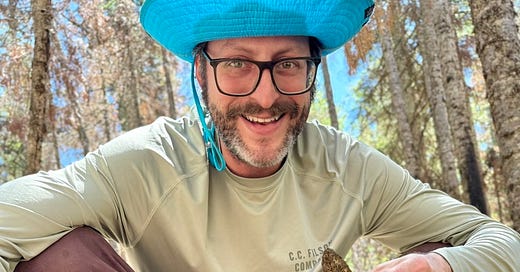



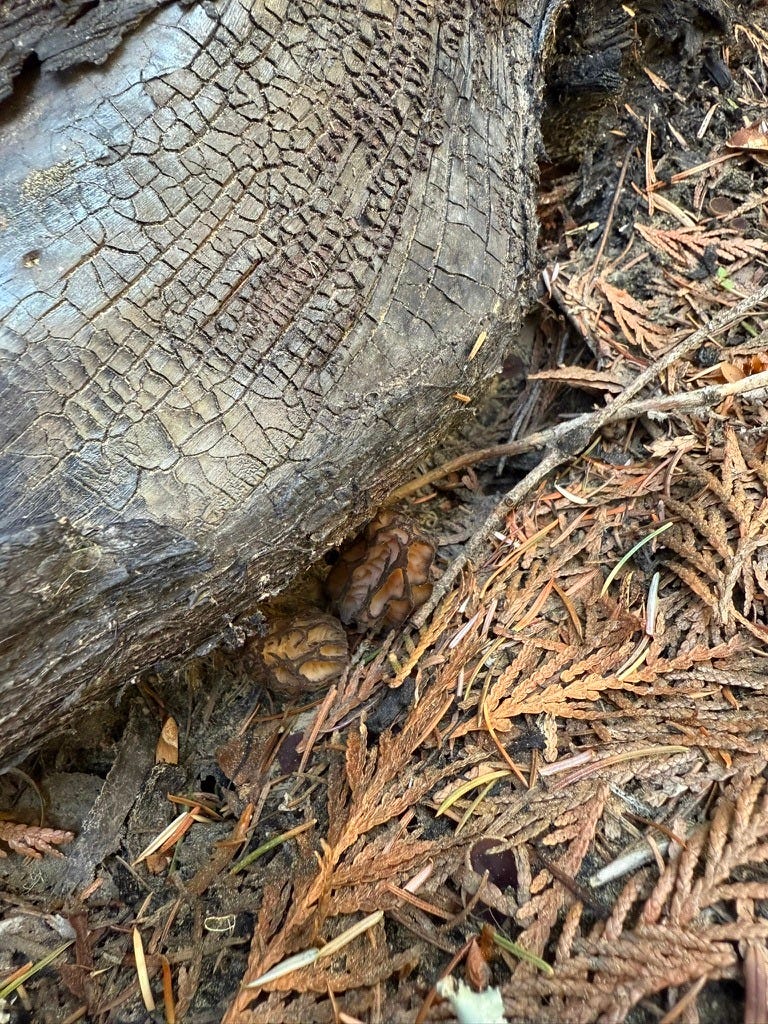
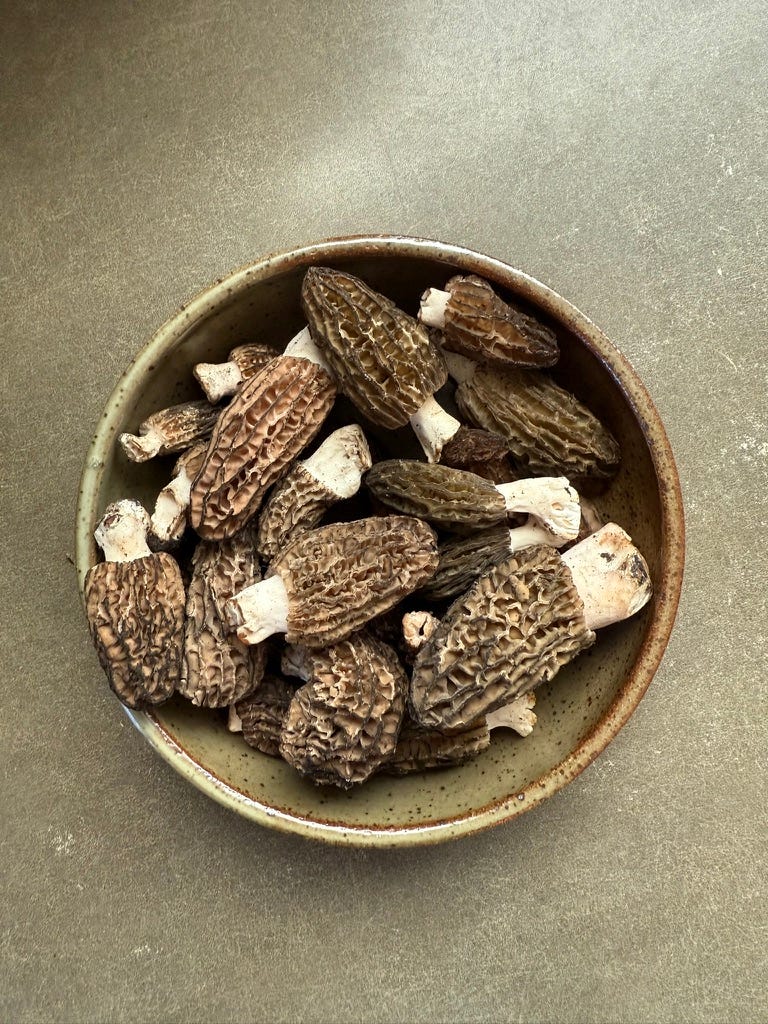
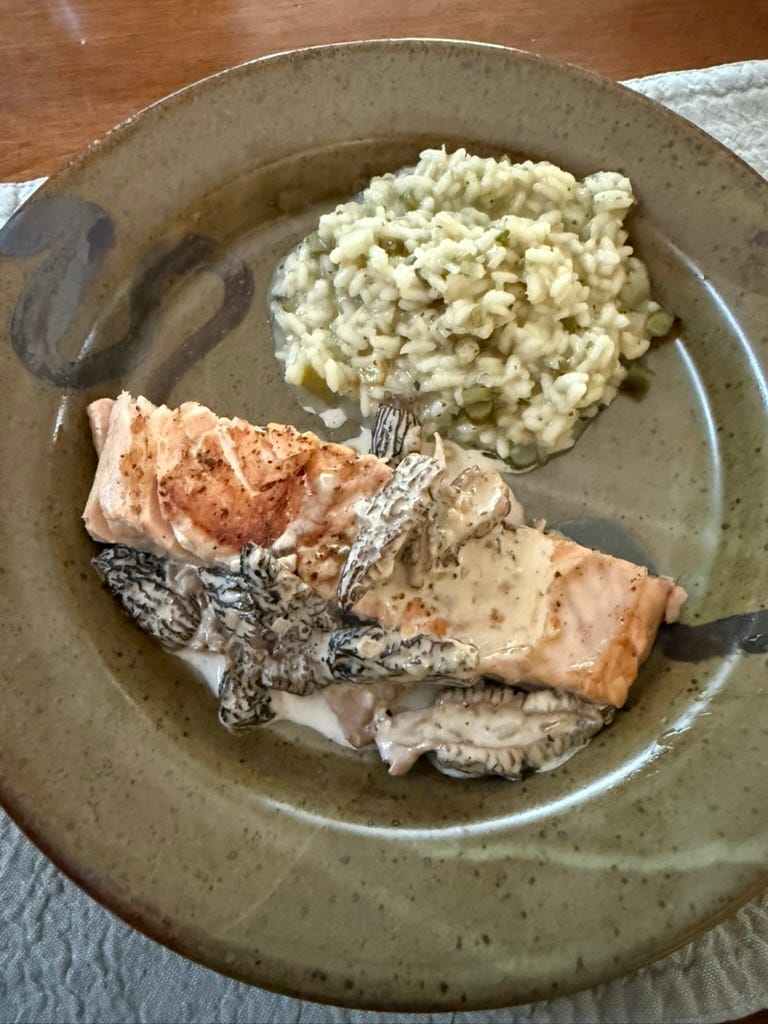
That photo of Andy is money!